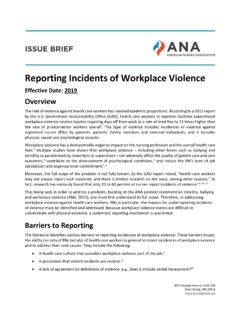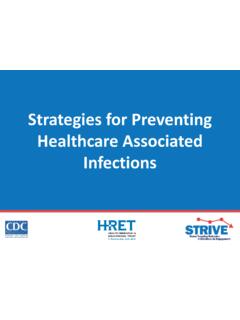Transcription of Clostridioides difficile Infection: Preventing Transmission
1 Clostridioides difficile Infection: Preventing Transmission 1. Presenter Karen Jones, RN, MPH, CIC. Clinical Research Project Coordinator University of Michigan Contributions by Erik Dubberke, MD, MPSH. Washington University School of Medicine Linda Greene, RN, MPS, CIC, FAPIC. University of Rochester, Highland Hospital Jeffrey Rohde, MD. University of Michigan 2. Learning Objectives Describe how Clostridioides difficile infection (CDI). Transmission occurs in health care settings Apply basic strategies to prevent CDI Transmission in health care settings 3. Impact on Patients and Health Care Facilities Illness May be self-limiting to life-threatening Increased length of stay Additional costs to treat Financial penalty (Image source: Antibiotic Resistance Threats in the United States, CDC, 2013; Guide to Preventing Clostridioides difficile Infections, APIC, 2013).
2 4. How Transmission Happens Patient skin and environment (especially bed and toilet areas) of a patient with C. diff become contaminated with C. difficile C. diff spores make pathogen removal difficult Bacteria and spores are passed to other patients ( by healthcare personnel hands and ingested) by health care personnel hands, shared equipment and contaminated surfaces (Image source: CDC, 2015. Dubberke ER, Infect Control Hosp Epidemiol, 2014). 5. Strategies to Prevent Transmission Identify CDI early Clinically significant diarrhea Initiate Contact Precautions ( private room, dedicated equipment, frequent cleaning, gloves and gown upon entry) promptly Promote strict glove use and hand hygiene Ensure appropriate cleaning and disinfection of equipment and environment (Dubberke ER, Infect Control Hosp Epidemiol, 2014).
3 6. Contact Precautions Place patients with known or suspected CDI on Contact Precautions Gown and gloves, following Contact Precautions protocol Private room, if possible, with dedicated bathroom/commode and other equipment Blood Pressure cuff Maintain Contact Precautions for duration of CDI illness (Dubberke ER, Infect Control Hosp Epidemiol, 2014). 7. Strict Glove Use Glove use is essential when caring for patients with CDI. Gloves offer the best protection against C. diff Transmission Change gloves during patient care if: Gloves become contaminated during patient care Moving from a dirty to clean patient care activity Clean hands before reaching into a box of clean gloves Remember: it's important to avoid contaminating the environment and yourself with soiled gloves (Image source: Sequence for putting on PPE, CDC.)
4 Dubberke ER, Medscape, 2015; Guide to Preventing Clostrididium difficile Infections, APIC, 2013). 8. Hand Hygiene Clean hands prior to entering patient environment Alcohol-based hand rub (ABHR) unless hands are visibly soiled Clean hands immediately after glove removal Clean hands prior to leaving patient's environment ABHR or soap and water Remember: ABHR is a preferred measure unless hands are visibly soiled (Image source: Hand Hygiene: Why, How & When?, WHO, 2009. Dubberke ER, Infect Control Hosp Epidemiol, 2014). 9. Patient Equipment and Environment Single-use patient or disposable supplies are preferred Equipment and supplies dedicated to a patient with CDI. For shared equipment and the environment: What's the plan for cleaning and disinfection?
5 Refer to manufacturers' instructions Standard hospital disinfectant for non-outbreak situations Responsibility (Dubberke ER, Infect Control Hosp Epidemiol, 2014). 10. An Example of a Responsibility Framework Item Standard Method Responsible When visibly soiled Environmental Crash cart Disinfectant wipe or dusty services (EVS). Exam lights After use Disinfectant wipe Clinical Staff Hospital-approved Feeding pumps Discharge EVS. disinfectant When visibly soiled Disinfectant wipe;. Computer keyboard or dusty; regular IT-approved User; EVS. intervals method Hospital-approved Glucose meter After each use User disinfectant Between patients;. Isolettes Disinfectant wipe Nursing weekly Vital sign machine Between patients Disinfectant wipe Nurse assistant (Adapted from: Shore Health System, University of Maryland.)
6 11. Engaging Patients and Families Antimicrobial awareness Hand hygiene If you do not see health care providers clean their hands, please ask them to do so.. Visitors (CDC, 2015. ). 12. Patient Scenario Previously healthy 75-year-old woman named Mrs. Wilkins suffered a hip fracture Post-operatively, she developed a catheter-associated urinary tract infection and was placed on ciprofloxacin On day five, she was transferred from the orthopedics unit to inpatient rehab She began having severe surgical site pain along with watery diarrhea She was diagnosed with CDI and transferred to a surgical ward for suspected post-op infection A need for Contact Isolation was not conveyed to the receiving unit Disclaimer: All case studies are hypothetical and not based on any actual patient information.
7 Any similarity between a case study and actual patient experience is purely coincidental. 13. Barriers and Strategies: Communication Barrier: Communication issues among staff When patient is transferred between nursing units When transferred to lower or higher level of care When patient leaves the unit Leaves for therapy, radiological exams, etc. When patient moves among disciplines Surgery and rehabilitation services Strategy: Clear patient hand-off communication Ticket to Ride or other visual alert Build alerts into the electronic medical record (Guide to Preventing Clostridium difficile Infections, APIC, 2013). 14. Barriers and Strategies: Cleaning and Disinfecting Barrier: Improper room and equipment cleaning and disinfection Strategy: Standardize and clearly define cleaning and disinfection procedures Who is responsible for what?
8 Educate those responsible Use checklists (Guide to Preventing Clostridium difficile Infections, APIC, 2013). 15. Barriers and Strategies: Contact Precaution Compliance Barrier: Poor compliance with Contact Isolation Strategy: Multidisciplinary approach Champions from multiple disciplines Enlist frontline staff to better understand barriers Use audits and feedback (Guide to Preventing Clostridium difficile Infections, APIC, 2013). 16. Key Messages CDI can be passed by the hands of health care personnel, by shared patient equipment and by contaminated surfaces Strict glove use, Contact Isolation with disposable and/or dedicated patient equipment and attention to environmental cleaning will prevent Transmission Barriers are common; consider strategies to work together to reduce patient risk 17.
9 References Antibiotic Resistance Threats in the United States, 2013. US Department of Health and Human Services. Centers for Disease Control and Prevention, CDC. Available at: Association for Professionals in Infection Control (APIC), Guide to Preventing Clostridium difficile Infections, 2013. Cohen SH, Gerding DN, Johnson S, et al. Clinical Guidelines for Clostridium difficile Infection in Adults: 2010 Update by the Society for Healthcare Epidemiology of American (SHEA) and the Infectious Diseases Society of America (IDSA). Infection Control Hosp Epidemiol. 2010; 31: 431-55. Dubberke ER, Carling P, Carrico R, et al. Strategies to prevent Clostridium difficile infections in acute care hospitals: 2014 update. Infect Control Hosp Epidemiol. 2014; 35(Suppl 2): S48-65.
10 Dubberke ER. Preventing Clostridium difficile Infection: Clarifying Common Misperceptions. Medscape. 2015. Available at: Preventing Clostridium difficile Infection, 2015. FAQs Factsheet. Centers for Disease Control &. Prevention (CDC). Available at: 18. Speaker Notes 19. Speaker Notes: Slide 1. Welcome to the third module on Clostridioides difficile infection, or CDI. This module will discuss Preventing Transmission of the disease within health care settings. 20. Speaker Notes: Slide 2. This module was developed by nation infection prevention experts devoted to improving patient safety and infection prevention efforts. 21. Speaker Notes: Slide 3. Module 1, The Overview of CDI, discussed how antimicrobial stewardship is key to decrease risk of CDI if Transmission occurs.


















